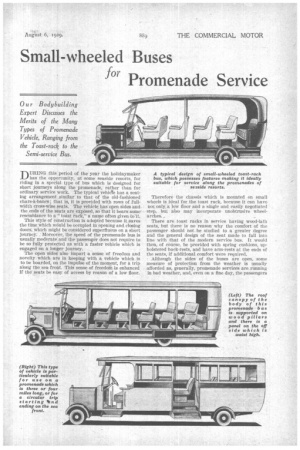Small-wheeled Buses
Page 59

Page 60

If you've noticed an error in this article please click here to report it so we can fix it.
for
Promenade Service
TAURING this period of the year the holidaymaker 1-1 has the opportunity, at some seaside resorts, for riding in a special type of bus which is designed for short journeys along the promenade,rather than for ordinary service work. The typical vehicte has a seating arrangement similar to that of the old-fashioned chars-it-bancs ; that is, it is provided with rows of fullwidth cross-wise seats. The vehicle has open sides and the ends of the seats are exposed, so that it bears some resemblance to a "toast rack," a name often given to'it.
This style of construction is adopted because it saves the time.which would be occupied in opening and closing doors, which might be considered superfluous on a short journey: Moreover, the speed of the promenade bus is usually moderate and the passenger does not require to be so fully protected as with a faster vehicle which is engaged on a longer journey.
The open sides also impart a sense of freedom and novelty which are in keeping with a vehicle which is to be boarded, on the impulse of the moment, for a trip along the sea front. This sense of freedoin is enhanced if the seats be easy of access by reason of a low floor. Therefore the chassis which is mounted on small wheels is ideal for the toast rack, because it can have not only a low floor and a single and easily negotiated step, but also may incorporate unobtrusive wheelarches. , There are toast racks in service having wood-lath seats, but there is no reason why the comfort of the passenger should not be studied to a greater degree and the general design of the seat made to fall into line with that of the modern service bus. It would then, of course, be provided with spring cushions, upholstered hack-rests, and have arm-rests at the ends of the seats, if additional comfort were required.
Although the sides of the buses are open, some measure of protection from the weather is usually afforded as, generally, promenade services are running in bad weather, and, even on a fine day, the passengers
may desire some protection from the wind and, perhaps, the dust.
The runabout usually has a fixed-roof canopy extending the full length of the vehicle, with panelling at the sides and back of the rear seat and the usual screen in front. This canopy is supported on metal stanchions or wood pillars, the latter forming convenient points at which to fasten commode handles.
If a supporting pillar be provided at the end of each row of seats, the stanchions are close enough together to allow a roller shutter to be mounted between each pair. These shutters reach from the roof to the floor and, when extended, form a weather shield or protection panel on one or both sides of the bus. with the advantage that the number of seats enclosed may be varied as necessary. The shutter has openings in its upper part, so as to facilitate ventilation and permit a certain amount of natural lighting. The roof, however, does not require, in order to support it properly, a pillar at the end of each seat, so that if roller shutters be not required the pillars may be fewer and the general appearance enhanced.
Instead of free access being provided at both ends of the seats, the proprietor may consider It advisable to restrict entry to the near side only. If this be so, a permanent panel which extends from the floor level to that of the waist is fitted at the off ohS side. Roller shutters, blinds or drop windows may then be employed, if necessary, above the waist, with the advantage that the panelling below this level is better designed for resisting contact with the passengers' feet than the laths or a roller shutter.
Promenades and 'marine drives," of course, vary in length, and it way happen that the journey extends to three or four miles. In these instances, there will be scope for providing ample protection for the passengers and the bus will then be constructed more on the lines of the service vehicle.
The oromenade bus may be similar to a single-decker with a wide central entrance having no dolor, so that freedom of access is still maintained. The chassis, again, has small wheels and the driver's seat is open, that is, it has no doors or protection above the waistline. Another type of bus which is practically of an ordinary service pattern, except that it has an extremely low floor, has front and rear side entrances which are equipped with doors. Drop windows are provided, or spring-roller blinds may be disposed between the pillars, thus providing ample protection for the passengers.
Another bus which could be used for promenade trips has a composite type of body. The front part has two or more rows of seats, which may have open ends, or it may be panelled to the waist, doors being fitted. The rear part of the body then consists of a saloon which has a side entrance, either in front or behind the wheelarches, and with or without an entrance at the front end of the central gangway of the saloon. The enclosed portion may be fitted with a sliding roof.
If the vehicle approximates to the service pattern, it may, on occasions, undertake longer journeys, 'such as a round trip, the sea front forming the start and the terminating point of the journey.














































































































